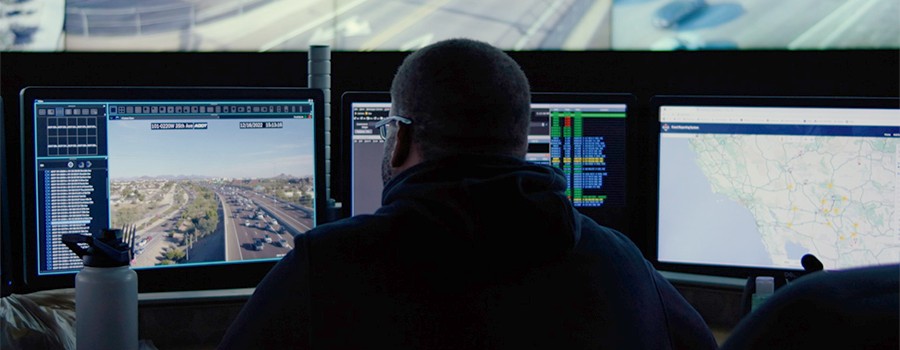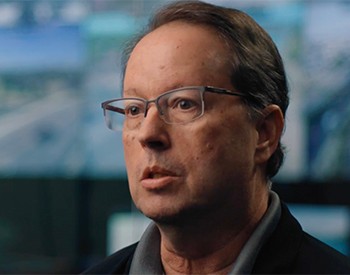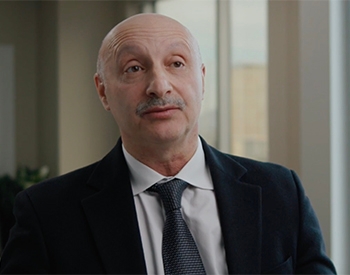When you're driving on a highway, your goal is to get to your destination as swiftly and safely as possible. Although you may not see them in action, regional agencies like the Arizona Department of Transportation (ADOT) are working hard behind the scenes to make sure your trip goes smoothly. "We serve the drivers in the state of Arizona. We maintain the roadways, the interstate highways and the state highway system," said John Roberts, Engineering Manager at ADOT. "We help people to drive to their destinations as safely as possible and as expediently as possible while being good stewards to the taxpayers."
Before setting out on your journey, you might research the best route using an app like Google Maps or a GPS. Those technologies can help get you on your way. But how do you find out if you're approaching a dangerous curve or if the conditions have made the road ahead impassable? And how do you get that notification in time to slow down or change your route?
Transportation agencies like ADOT want to get this crucial information to drivers as quickly as possible, but their current options are limited. "If we want to communicate with drivers, we generally do it through dynamic message signage that's on the freeways or the state highway system. There is an AZ 511 application that drivers can have on their phones where they can get updates as well," said Roberts. "But there are a lot of places on the roadway where we just can't communicate directly with them. If there's a road closure or if there's a work zone up ahead, we want to make sure they know that there's some potential for a slowdown or some other deviation in driving."
Understanding traffic safety alert challenges
Then there's the challenge of collecting all of this safety information to begin with. To achieve a better real-time understanding of road conditions, agencies like ADOT have installed complex hardware such as light detection and ranging (LIDAR) on the road ways. This equipment can be expensive, however, so agencies must be selective about where they use it. In theory, ADOT could equip individual vehicles with advanced hardware that performs this detection on its own using machine learning and video analytics, but this option could also be cost-prohibitive at scale. Automotive manufacturers, uncertain of the ever-changing regulatory environment, are also hesitant to invest in this technology. Likewise, transportation agencies have traditionally invested in building out roadway infrastructure as a means of making safer driving conditions.
Transportation agencies have also been adopting smart city technologies, such as smart cameras and video sensors to monitor traffic and identify road safety incidents. However, these connected technologies can require a significant capital outlay at a time when budgets are tight and funding is hard to come by. Although local governments have recently begun diverting infrastructure funding to support these initiatives, there's only so much to go around. Internet of Things (IoT) solutions also require considerable IT expertise to implement, manage and maintain—and many transportation agencies don't yet have all of the necessary skill sets in-house.
These constraints put organizations like ADOT in a bind. When they can only afford to monitor their roadways in a few limited locations, then they can't access a complete view of traffic safety conditions, let alone promptly notify drivers about what to expect. This problem doesn't just affect commuters trying to get home after a long day at work. It also has serious implications for situations when severe weather develops, dangerous queues pose a threat to traffic safety, work zone safety issues arise or first responders need to reach the scene of an accident.


We serve the drivers in the state of Arizona. We maintain the roadways, the interstate highways and the state highway system. We help people to drive to their destinations as safely as possible.
John Roberts, Engineering Manager, ADOT
Assessing a potential solution with Verizon broadband networks: V2X and virtual RSU
As agencies like ADOT search for solutions to challenges like these, metropolitan planning organizations like the Maricopa Association of Governments (MAG) are there to help. "MAG is a regional planning agency—that means that we develop transportation plans, among other things. But MAG is also a technical hub. We have various programs that are looking into intelligent transportation systems, transportation safety and emerging transportation technologies. We bring our findings to our members so that they can capitalize on these innovations and find the most effective and efficient solutions for their transportation problems," said Vladimir Livshits, Director of Transportation Technology at MAG.
Through MAG's Emerging Technology Program and the funding it provided, ADOT was able to partner with Verizon on a pilot project to test and validate the viability of delivering valuable, potentially life-saving alerts using cost-effective, highly scalable vehicle-to-everything (V2X) capabilities. For this pilot project, Verizon proposed leveraging V2X in combination with a virtual roadside unit (virtual RSU)—essentially, a virtualized version of the physical roadside units that collect key traffic data today.
V2X makes it possible for vehicles to communicate with existing infrastructure like roads and traffic signals, with traffic operation centers and even with other vehicles. A virtual roadside unit is highly flexible. It can integrate with ADOT's Operations Center using application programming interfaces, and it's capable of linking with any cloud or data center, in addition to IoT devices that provide more functionality, such as video feeds and LIDAR.
This model also takes advantage of public multi-access edge compute (MEC) infrastructure, allowing complex computation and routing of data—closer to where traffic conditions are unfolding—without having to outfit vehicles or the transportation infrastructure with expensive equipment that was specially designed for that purpose.
Agencies like ADOT can leverage Verizon's cellular network and software centric approach instead of relying on more traditional hardware that would otherwise have to be placed in vehicles and on road ways. They can then enable the V2X messaging to ensure drivers get the timely smartphone alerts they need to safely pass through work sites or around dangerous curves. Should the solution prove viable for a comprehensive range of transportation safety use cases, they could even one day use V2X and virtual RSU to build a digital roadway infrastructure cost-effectively and at scale.
Testing three alerts that could improve road safety
For this pilot project, ADOT wanted to test and validate three core use cases: back-of-queue alerts, curve speed alerts and work zone alerts. In a back-of-queue scenario, drivers need a timely notification that they're approaching a point of traffic congestion on the highway so they can slow down or take a new route. Curve speed alerts warn drivers that a sharp curve is ahead and they must reduce their speed to safely navigate it. When work crews are performing maintenance on the roadway, work zone alerts let drivers know they must switch lanes or proceed with caution so both the drivers and the workers stay safe
Back-of-queue alerts
"The thing we did that I'm most proud of was the dynamic back-of-queue use case because there were several different systems that we had to use," said Roberts. "We used third-party data that was aggregating what was happening on the roadway at that time, so we could understand the speeds at different parts of the freeway. We were actually able to understand that there was a part of the freeway that was much slower than, say, a half a mile ahead or behind it." ADOT was able to notify Verizon of the specific locations where it wanted to broadcast a back-of-queue safety alert and then push that alert through to the smartphone app.
Jimmy Kim, Managing Client Partner, Verizon Business, also explained exactly how this works. "When ADOT detects these traffic queue buildups, they can dynamically paint a geofence around those locations, using our virtual roadside unit. When ADOT's test vehicles enter the geofence, they receive the back-of-queue alerts in real time through a smartphone app," said Kim. "I thought it was pretty spectacular that we were able to put all those disparate systems together and make that work," Roberts added.
Curve speed alerts
Sudden, steep curves are among the most treacherous road conditions a driver can encounter. "When a lot of motorists whip around the curves at these interstate freeways, they don't know that the curve has got this pitch—that it's sharp and that they need to slow down," said Kim. To test and validate this use case, ADOT identified all of the places in the state of Arizona where there were already curve speed advisories in effect. "Our pilot project identified one of the locations where a speed advisory was in place. We then broadcast the information based on the geographic location of where that sign was and the appropriate location where someone in a car with a cellphone would hear that warning," said Roberts.
Work zone alerts
For the work zone use case, ADOT identified locations on the freeway near Phoenix where a driver might see a sign indicating a work zone was ahead and advising the driver to slow down or merge with another lane. "We broadcast that information to the edge computer, and then what we got back through the cellphone from Verizon is actually a verbal indication of what was going on. So, someone who was driving could hear this and react accordingly," he noted. This audio alert could prove valuable for maintaining traffic safety in difficult situations when it might be risky for a driver to glance at a smartphone screen to find out what's going on.
Establishing a successful proof of concept
MAG was pleased that the pilot project successfully tested and validated ADOT's three use cases for traffic safety alerts. "We always say that information is the key and delivering information to travelers in a timely manner is very important, but I think all agencies struggle with this issue to a degree. We have various hardware and software solutions for deployments affecting infrastructure, but it all costs money, and it all requires additional investment," said Livshits.
This proof of concept established that a virtual RSU platform, leveraging public MEC and ubiquitously available cellular communications, could enable a more cost-effective method of disseminating this information to drivers while making use of existing infrastructure. Livshits said, "What was very appealing here is that we can deliver messages right to the travelers through audiovisual means or whatever is the safe way of operating in a particular situation. This particular pilot allowed us to reach travelers with timely messages that will require some action on their behalf, or at least will inform them and prepare them to take action."
"We've been looking for an opportunity to move forward on the V2X front for a while. And frankly, we're one of the first organizations in the country that is looking in this direction and trying something like this. But what's unique about this pilot is that it was something tangible—something that we think will help us to move the region forward. And we're happy that we're able to partner with ADOT to make this pilot a reality," Livshits added.
ADOT shares the same enthusiasm about how the pilot project went. "We're excited about the possibilities," said Roberts. "What we'd like to do next is scale this out. ADOT is actually in the process of implementing the solution in a cloud environment because it gives us the ability to scale up faster ourselves. We also want to see if we can communicate to many more cellphones. We'd like to see how the system does under load. We'd also like to understand how this performs in some of the use cases with our traffic signals. Those are areas that are really important for us to see if this is a viable solution for the future."

We've been looking for an opportunity to move forward on the V2X front for a while. And frankly, we're one of the first organizations in the country that is looking in this direction and trying something like this.
Vladimir Livshits, Director of Transportation Technology, MAG (Maricopa Association of Governments)
Taking a positive step toward safer Arizona roadways
Transportation agencies and the metropolitan planning organizations that support them, such as ADOT and MAG, are always looking for ways to enhance traffic safety on the public roadways the agencies oversee. When looking for ways to give drivers more timely and relevant alerts about traffic and road conditions, however, ADOT initially found that the available solutions were complex, costly and challenging to manage. Faced with limited funding, ADOT found itself constrained.
By participating in MAG's Emerging Technology Program and engaging Verizon on a pilot project to demonstrate the potential of V2X enabled through MEC and cellular connectivity, ADOT was able to test and validate three important use cases: back-of-queue alerts, curve safety alerts and work zone alerts. Tapping into ubiquitous cellular broadband coverage and leveraging the power of MEC to support data computation and message delivery at the edge, ADOT confirmed it's possible to issue critical safety alerts to drivers on a smartphone app in near real time.
Although this pilot project is just a start, the initial results are promising. "If we can implement this system in the state of Arizona, we believe it will make drivers safer and better informed. We believe that we are being good stewards to our taxpayers by implementing something that's less costly and easier to operate and maintain," said Roberts. "I think it still remains to be seen exactly how all this will unfold and how to develop it. But what's important is to learn the lesson—to make the first step and then another and then another step—because if we wait for the perfect solution, that will never happen," said Livshits.
Explore solutions
Learn more about the benefits of Public MEC.